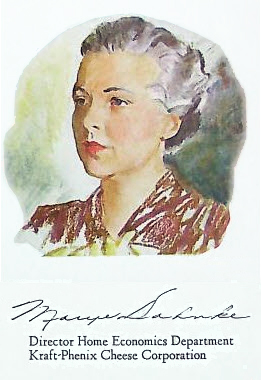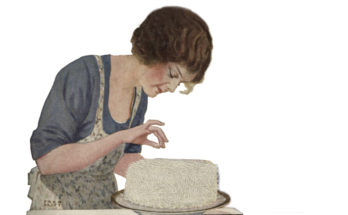
In 1909 Americans ate only 3-3/4 pounds of cheese per year. Now, in the 2020s Americans eat over 40 pounds of cheese per year. It’s easy to do, as cheese is built into many processed foods, and since the 1920s home economists — mostly Kraft’s Mary Dahnke — removed objections by developing and promoting fun new recipes for the public.
Before Marye Dahnke was hired, the introduction of an early-1920s Kraft’s booklet, The Perfectly Digestible Cheese stated, “In the United States…the per capita consumption of cheese…is far below that of other nations, especially of Europe...” And just by the title it appears that Kraft’s hurdle was to remove Americans objection to eating cheese in the first place. This objection to cheese was seen over and over again in ads from other cheese companies of the time. That’s difficult to imagine today.
Professional Biography
Marye Dahnke is credited to removing objections to eating cheese, and increasing consumption in America to near what it is today.
Marye Gretchen Dahnke (1897-1966) was born in Union City, Tennessee. After receiving a Bachelor of Science degree in Home Economics at Columbia University in 1921, she was a hospital dietician, managed a resort in Maine for two summers, and taught Home Economics at the University of Tennessee. She said she preferred the “conflict of business” rather than the “rewards of teaching.” * See Life Story, below, for more information about her personal life.
The Kraft brothers hired Marye Dahnke [earliest photo, google books] on contract in 1925 to promote Kraft to the American public. This same year she wrote an article which stated Kraft’s challenge, “...I have often wondered why the average housewife uses so little cheese. Here in America we think of it as an occasional accompaniment to apple pie or as a filling for sandwiches….“
Dahnke began by distributing free samples at grocery stores, and traveled the country demonstrating ways to use cheese. She dressed in pastels to reflect the dress of housewives attending the events instead of the sterile white clothes often worn then by food demonstrators. At this point she wasn’t even promoting Kraft cheese, but just the notion of cheese use. Kraft need not worry which brand the audience would choose, as Kraft Cheese Company was the largest cheese business in the world. About 1926 Dahnke officially was hired at Kraft. They created an in-house test kitchen for her to continue creating cheese recipes on the top of the Kraft factory at 400 Rush Street, next to a dock [google map shows route to her home] on the Chicago river. From this dock, product deliveries by ship were transported to New York or New Orleans, thus anywhere in the world. Kraft published the cheese recipes in advertising booklets for free distribution.
Kraft advertising, with the assistance of Marye Dahnke, expanded into radio and television, even hosting their own show from 1947 to 1958, Kraft Television Theater. Dahnke became the director of Kraft’s Consumer Service department which she built. She was the chairman of the Illinois Home Economics Association, a member of the American Home Economics Association, the American Dietetic Association, and the Institute of Food Technologists. She retired in 1962.
Life Story
On a personal note, Marye Dahnke was the third of six sisters and one brother–the youngest. Her father, George Dahnke, moved with his wife from Nashville, Illinois to Union City Tennessee where he bought a bakery in 1887. He added confections to the bakery line, and the place was “known as ‘Dahnke’s Cafe’ with restaurant and fountain beverages–one of the most popular and one of the very few of its kind in West Tennessee.” In 1900 he organized the Dahnke-Walker Milling Company which became “a large shipping business with flour, meal, and feed products with a capacity of 1400 barrels daily.” Now we understand why Marye entered into the food business—she grew up with it.
Her father was also an active stock owner in a local ice & coal company, a local canning company, and others. Yet, his co-ownership of over 5,000 acres of undeveloped land in the Obion River which they hoped to ditch and drain led the family and business to bankruptcy. Within days during the bankruptcy, he committed suicide, dying within a few hours in 1921. The bankruptcy lasted in court to 1926 or longer. The insurance policy on his life was payable to the bankrupted Dahnke-Miller Milling Co., yet his wife was able to buy back the homestead at auction. The year George Dahnke died, 1921, was the year Marye graduated from Columbia University.
We know that Marye began working for Kraft in 1925. In 1930, Marye, 32, was renting an apartment with her sister Margie, 22, in the well-located DeWitt Apts. at 244 E. Pearson St. Chicago. I conject that her sister also worked at Kraft as both were listed as working in a manufacturing office, Margie a stenographer, and Marye in educational advertising.
In 1940 Marye lived alone at 180 E Delaware Place, again in downtown Chicago. For the census she said she was Economic Director for Cheese Prod. and earned over 5000 annually.
On Feb 15 1947 Marye Dahnke was no longer alone, as she married Vernon D. Beatty, Brooklyn born, 1919 graduate of the University of Chicago, a former military officer, and during WWII the first director of advertising of the War Food Administration. When Marye and Vernon married he was advertising manager for the wholesale meat packers, Swift & Co. where he worked since c. 1933. The major Swift location was at the Union Stockyards. Marye and Vernon were the ideal accompaniment, the protein couple–meat and cheese!
Marye and Vernon married in her hometown of Union City, Tennessee, where her mother and six of her siblings would have been able to attend. The couple in 1950 both worked 55 hours in a week, and resided at the apartment where she was once alone. Vernon had been living a straight shot west at 2015 Arlington Ave. in Evanston. There’s plenty more information, such as Vernon’s father was a rector and his mother was born in England, but I’ll stop there. God bless.
Marye Gretchen Dahnke Beatty retired in 1962. But what happened to Vernon?
Books by Marye Dahnke
1925 – New Uses for an Old Food (Dec. article, National Live Stock Producer)
1930 – Marye Dahnke’s Best Recipes for Using the Versatile Velveeta
1931 – Cheese –and Ways to Serve It [Reddit]
1931 – Kraft-Phenix menuettes. Quick turns to distinctive menus
1933 – Kitchen Fresh Ideas. Selected Recipes. Salads and Sandwiches You’ll Love to Make-With Kraft Kitchen Fresh Salad Products
1935 – The Romance of Cheese (catalog)
1938 – Favorite Recipes from Mary Dahnke’s File [Reddit]
1940 – Star Veg-All Recipes by America’s Cooking Stars
1942 – Cheese Cook Book (Book) [Reddit]
1954 – Marye Dahnke’s Salad Book (Book)
1955 – Appetite Tempters: From the Kraft Kitchen (12-panels)
Kraft’s History
Kraft was the first to patent a processed blended cheese. Along with selling tins in the US, during WWI the US government ordered six million pounds of Kraft’s shelf-stable tins for soldiers overseas, securing Kraft’s success. Velveeta, a different type of shelf-stable blended cheese –a cheese we associate with Kraft–was in fact invented by Emil Frey in 1918 and patented in 1925. Two years later Kraft purchased his Velveeta Cheese Company. Kraft also acquired MacLaren’s Imperial Cheese, a Canadian soft cheese sold in glass containers.
Kraft became Kraft-Phenix in 1928 when Phenix Cheese, makers of Philadelphia Brand Cream Cheese, purchased the business. Late summer 1929 Kraft-Phenix was bought by Selected Industries, Inc. and affiliated investment groups. Late Oct, same year, 1929, was an announcement that Kraft-Phenix would be a unit, along with Hershey Chocolate Corp., and Colgate-Palmolive-Peet Co. in a new food company sponsored by National City Bank. This was done so the individual companies could benefit from each other’s distribution systems, etc.. I heard, but haven’t verified, that in 1930 Kraft-Phenix was purchased by National Dairy Products Corporation. I’m sure there’s a boatload of buying and selling since then, but here, we keep to the early history.


